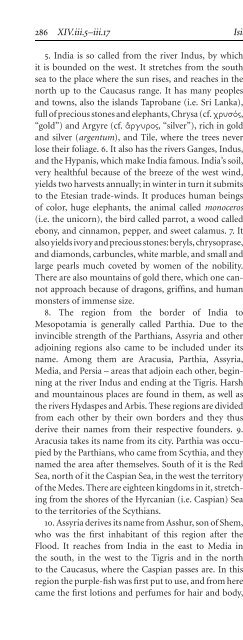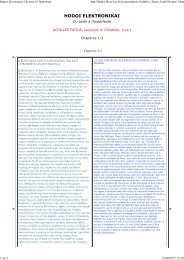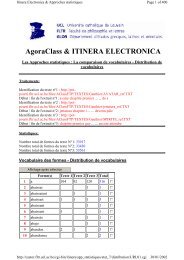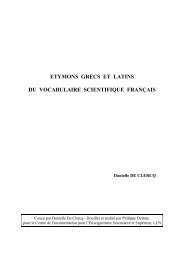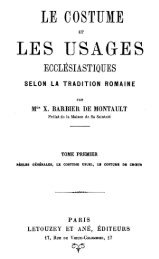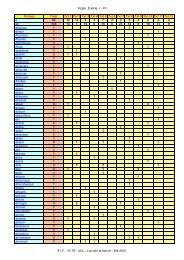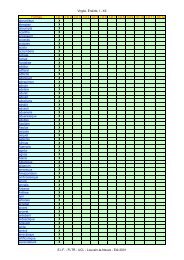The Etymologies of Isidore of Seville - Pot-pourri
The Etymologies of Isidore of Seville - Pot-pourri
The Etymologies of Isidore of Seville - Pot-pourri
You also want an ePaper? Increase the reach of your titles
YUMPU automatically turns print PDFs into web optimized ePapers that Google loves.
286 XIV.iii.5–iii.17 <strong>Isidore</strong> <strong>of</strong> <strong>Seville</strong><br />
5. Indiaissocalledfromthe river Indus, by which<br />
it is bounded on the west. It stretches from the south<br />
sea to the place where the sun rises, and reaches in the<br />
north up to the Caucasus range. It has many peoples<br />
and towns, also the islands Taprobane (i.e. Sri Lanka),<br />
full <strong>of</strong> precious stones and elephants, Chrysa (cf. ,<br />
“gold”) and Argyre (cf. , “silver”), rich in gold<br />
and silver (argentum), and Tile, where the trees never<br />
lose their foliage. 6.Italso has the rivers Ganges, Indus,<br />
and the Hypanis, which make India famous. India’s soil,<br />
very healthful because <strong>of</strong> the breeze <strong>of</strong> the west wind,<br />
yields two harvests annually; in winter in turn it submits<br />
to the Etesian trade-winds. It produces human beings<br />
<strong>of</strong> color, huge elephants, the animal called monoceros<br />
(i.e. the unicorn), the bird called parrot, a wood called<br />
ebony, and cinnamon, pepper, and sweet calamus. 7. It<br />
also yields ivory and precious stones: beryls, chrysoprase,<br />
and diamonds, carbuncles, white marble, and small and<br />
large pearls much coveted by women <strong>of</strong> the nobility.<br />
<strong>The</strong>re are also mountains <strong>of</strong> gold there, which one cannot<br />
approach because <strong>of</strong> dragons, griffins, and human<br />
monsters <strong>of</strong> immense size.<br />
8. <strong>The</strong> region from the border <strong>of</strong> India to<br />
Mesopotamia is generally called Parthia. Due to the<br />
invincible strength <strong>of</strong> the Parthians, Assyria and other<br />
adjoining regions also came to be included under its<br />
name. Among them are Aracusia, Parthia, Assyria,<br />
Media, and Persia – areas that adjoin each other, beginning<br />
at the river Indus and ending at the Tigris. Harsh<br />
and mountainous places are found in them, as well as<br />
the rivers Hydaspes and Arbis. <strong>The</strong>se regions are divided<br />
from each other by their own borders and they thus<br />
derive their names from their respective founders. 9.<br />
Aracusia takes its name from its city. Parthia was occupied<br />
by the Parthians, who came from Scythia, and they<br />
named the area after themselves. South <strong>of</strong> it is the Red<br />
Sea, north <strong>of</strong> it the Caspian Sea, in the west the territory<br />
<strong>of</strong> the Medes. <strong>The</strong>re are eighteen kingdoms in it, stretching<br />
from the shores <strong>of</strong> the Hyrcanian (i.e. Caspian) Sea<br />
to the territories <strong>of</strong> the Scythians.<br />
10.Assyria derives its name from Asshur, son <strong>of</strong> Shem,<br />
who was the first inhabitant <strong>of</strong> this region after the<br />
Flood. It reaches from India in the east to Media in<br />
the south, in the west to the Tigris and in the north<br />
to the Caucasus, where the Caspian passes are. In this<br />
region the purple-fish was first put to use, and from here<br />
came the first lotions and perfumes for hair and body,<br />
with which the luxury <strong>of</strong> the Romans and the Greeks<br />
abounded. 11. Mediaand Persia (Persida) are named<br />
after the kings Medus and Persus, who invaded these<br />
regions in war. Among these Media obliquely borders the<br />
Parthian kingdoms in the west; in the north it is enclosed<br />
by Armenia; in the east it overlooks the Caspians; in the<br />
south, Persia. Its soil produces the tree ‘Medica,’ which is<br />
rarely found in any other region. <strong>The</strong>re are two Medias,<br />
Greater and Lesser Media. 12. Persia reaches in the east<br />
to the Indus, in the west it has the Red Sea, in the north it<br />
touches Media, in the south-southwest Carmania, which<br />
is connected to Persia and in which the most renowned<br />
city <strong>of</strong> Susa is located. Persia is the birthplace <strong>of</strong> the magical<br />
arts. <strong>The</strong> giant Nebroth went there after the confusion<br />
<strong>of</strong> the tongues and taught the Persians to worship fire,<br />
for in those regions everyone worships the sun, which is<br />
called El in their language.<br />
13. <strong>The</strong> word Mesopotamia has a Greek etymology,<br />
because it is “bounded by two rivers” (cf. ,“inthe<br />
middle”; , “river”), for in the east it has the<br />
Tigris, in the west the Euphrates. In the north its territory<br />
begins betweenMountTaurus and the Caucasus; in<br />
the south it borders on Babylonia, then Chaldaea, and<br />
lastly Arabia Felix. 14. <strong>The</strong>city <strong>of</strong> Babylon is the capital<br />
<strong>of</strong> Babylonia, from which it also derives its name.<br />
It is so famous that at one time or another Chaldaea,<br />
Assyria, and Mesopotamia came to be included under<br />
its name. 15.<strong>The</strong> word ‘Arabia’ means “sacred”; it is interpreted<br />
to mean this because the region produces incense<br />
and perfumes: hence the Greeks called it <br />
(“happy”), our Latin speakers beatus (“happy”). 2 Its<br />
woods produce both myrrh and cinnamon: it is the<br />
birthplace <strong>of</strong> the bird phoenix, and one finds precious<br />
stones there: the sardonyx, iris crystal, malachite, and<br />
opals. This region is also known as Sabaea, after the<br />
son <strong>of</strong> Cush whose name was Saba. In the east, this land<br />
extends in a narrow tract to the Persian gulf; in the north<br />
it borders on Chaldaea, in the west on the Arabian Sea.<br />
16. Itissaid that a certain Syrus, a native <strong>of</strong> the land,<br />
named Syria after himself. In the east its boundary is the<br />
Euphrates, in the west the Mediterranean and Egypt; in<br />
the north it touches Armenia and Cappadocia, in the<br />
south the Arabian Sea. Its territory extends immensely<br />
in length, more narrowly in width. 17. It comprises<br />
2 <strong>Isidore</strong> alludes to a common term for one section <strong>of</strong> Arabia,<br />
Arabia Felix, “Arabia the Blessed.”


